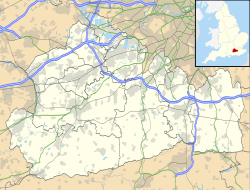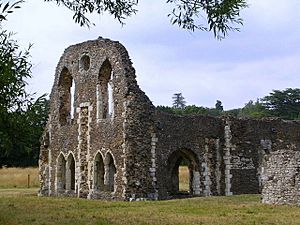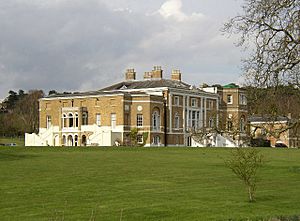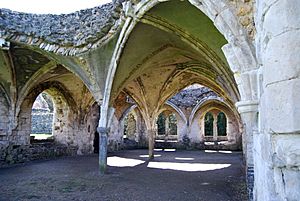Waverley Abbey facts for kids
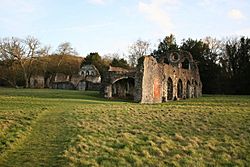
The ruins of Waverley Abbey
|
|
| Monastery information | |
|---|---|
| Full name | The Abbey of the Blessed Mary of Waverley |
| Order | Cistercian |
| Established | 1128 |
| Disestablished | 1536 |
| Mother house | L'Aumône Abbey, Normandy, France |
| Dedicated to | St Mary |
| People | |
| Founder(s) | William Giffard, Bishop of Winchester |
| Site | |
| Location | Borough of Waverley, Surrey, England |
| Coordinates | 51°12′00″N 0°45′36″W / 51.200°N 0.760°W |
| Visible remains | Ruins |
| Public access | Yes: Free of Charge Managed by English Heritage |
Waverley Abbey was the very first Cistercian monastery in England. It was started in 1128 by William Giffard, who was the Bishop of Winchester.
The abbey is located about 2 miles (3.2 km) southeast of Farnham, Surrey. It sits on a flat area near the River Wey. Because of its location, the abbey was often damaged by big floods. This meant it had to be rebuilt in the 1200s. Even though it was the first Cistercian abbey in England, and even started other abbeys, Waverley was not very rich. Its monks often faced poverty and hunger.
The abbey was closed down in 1536. This happened during King Henry VIII's Dissolution of the Monasteries. This was when many monasteries in England were shut down. After it closed, most of the abbey was taken apart. Its stones were used to build other local buildings. One of these was likely "Waverley Abbey House," built in 1723.
Today, Waverley Abbey House, the abbey ruins, and the land around them are a special protected area. The house is a Grade II* Listed building. This means it's an important historical building. The ruins are a Scheduled Ancient Monument, also meaning they are protected.
English Heritage now looks after the abbey ruins. They are open for everyone to visit for free.
Contents
History of Waverley Abbey
Waverley Abbey was founded by Bishop William Giffard on November 24, 1128. The first abbot (leader) and 12 monks came from L'Aumône Abbey in Normandy, France.
Bishop Giffard gave the new abbey all the land in the Waverley area. He also gave them two acres of meadow at Elstead. The monks could also cut wood from his forest at Farnham. Giffard's replacement, Henry of Blois (who was King Stephen's younger brother), gave the abbey more land. He also gave them permission to dig for turf, stone, and sand at Farnham.
King Stephen, Henry's brother, also gave land to the abbey. He freed the abbey from military duties and some taxes, like the Danegeld. In 1147, Pope Eugenius III freed the abbey from more taxes called tithes.
Adeliza of Louvain, who was King Henry I's wife, also gave land to the abbey. Faramus of Boulogne, King Stephen's nephew, sold the manor of Wanborough to the abbey. Later, King Richard I and King John confirmed the abbey's gifts and special rights.
Even with these gifts, the abbey was described as "slenderly endowed." This means it didn't have much money. In 1291, its income was only about £98. This was very little compared to other large monasteries. Despite this, many monks lived there. In 1187, there were 120 lay brothers and 70 religious brothers.
In its first 200 years, seven monks from Waverley Abbey became abbots at other monasteries. Since it was the first Cistercian Abbey in England, it became a "motherhouse." This means it helped start other Cistercian abbeys. These included Garendon Abbey, Forde Abbey, Coombe Abbey, and Thame Abbey. Many of these new abbeys then started their own "daughter" monasteries. For a while, the Abbot of Waverley Abbey thought he was more important than all other Cistercian Abbots in England. But the Abbot of Furness Abbey disagreed.
Challenges in the 1200s
The 1200s were a tough time for Waverley Abbey. In July 1201, a big storm caused a flood. The flood destroyed the abbey's crops. The abbey had to be rebuilt during this century. Most of the ruins you see today are from this time. Building the new abbey church started in 1203-04. A man named William, Rector of Broadwater, paid for it. But the monks faced hunger and had to ask other monasteries for food.
In 1208, King John took all church property. This happened because he had a fight with the pope. However, King John later visited Waverley Abbey. He allowed them to get their property back to finish rebuilding the church. Two years later, King John took away the abbey's special rights again. This was because the Cistercian order refused to give him money. Many monks ran away, and the abbot left at night. King John then stopped Cistercians from entering or leaving the country.
The situation got better when King John's fight with the pope ended. By October 1214, the abbot was even sent on official business for the King. The church building continued through these hard times. On July 10, 1214, five altars were blessed by Albin, Bishop of Ferns.
In 1225, King Henry III visited the abbey. He took communion there on December 16, 1225. The church was not fully finished until 1278. That was 74 years after it started! Nicholas de Ely, Bishop of Winchester blessed the church in honor of the Virgin Mary. A big feast followed, with many people attending.
The abbey's difficult century continued with more floods. In 1233, a flood reached 8 feet (2.4 m) high. It destroyed several bridges and buildings. Another flood in 1265 forced the monks to hide in the church. In 1291, the abbey was described as being in "grievous poverty." This was because their crops had failed.
The abbey wrote the Annals of Waverley. This was an important historical record for that time. But by the end of the 1200s, the abbey was becoming less important.
The Abbey Closes Down
In 1535, records showed the abbey had an income of about £174 each year. Because it was not one of the richest monasteries, it was closed down in 1536. This was part of King Henry VIII's Dissolution of the Monasteries. At that time, only thirteen monks lived there.
Abbots of Waverley
Here are some of the abbots who led Waverley Abbey:
- John, died 1128
- Gilbert, 1128-9
- Henry, died 1182
- Henry of Chichester, 1182, resigned 1187
- Christopher, 1187, removed 1196
- John II., 1196, died 1201
- John III., 1201, died 1216
- Adam, 1216, resigned 1219
- Adam II., 1219, resigned 1236
- Walter Giffard, 1236, died 1252
- Ralph, 1252, resigned 1266
- William de London, 1266
- William de Hungerford, resigned 1276
- Hugh de Leukenor, 1276, died 1285
- Philip de Bedwinde, 1285
- William, around 1316
- Robert, around 1335
- John III., 1344
- John IV., 1349, died 1361
- John de Enford, around 1385-6
- William Hakeleston, 1386, died 1399
- John Brid, 1399–1400
- Henry, around 1433
- William, around 1452
- William Martyn, 1456
- Thomas, around 1478 and 1500
- William, around 1509
- John, around 1529
- William Alyng, around 1535
Waverley After the Abbey Closed
After the abbey closed, its land was given to Sir William Fitzherbert. He was the king's treasurer. Most of the abbey buildings were torn down. Their stones were used to build other things nearby. Some stones were even used at Loseley Park.
The abbey's stones were also used to build Waverley Abbey House. This house was built in 1725 for Sir John Aislabie. He was a former Chancellor of the Exchequer. The house was designed by Colen Campbell. It was possibly meant for John's brother, William, who had returned from India. William died that same year. The house was then sold to Charles Child, and later to Thomas Orby Hunter in 1847.
Later, Orby Hunter added more parts to the house. Sir Robert Rich, 5th Baronet also made additions before 1786. Around 1796, a merchant named John Thomson bought it. He sold it around 1832 to George Thomas Nicholson. Nicholson rebuilt the house after a fire in 1833.
In the 1900s, the Anderson family owned Waverley Abbey. Rupert Darnley Anderson inherited it in 1894 from his brother. His father had bought it around 1869.
Today, Waverley Abbey House is separated from the ruins by a man-made lake.
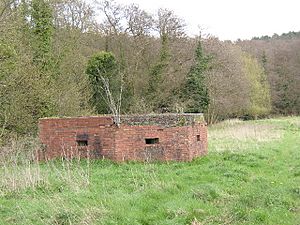
Waverley During the World Wars
During the First World War, Waverley Abbey House became the first country house to be a military hospital. It treated over 5,000 soldiers.
Part of the old abbey site was used for defenses during the Second World War. These defenses were called the "GHQ Line." They were set up to protect London. The abbey area still has many WWII items. These include anti-tank gun spots, "pillboxes," and anti-tank roadblocks.
Waverley Abbey Today
After the wars, Waverley Abbey House became a nursing home. In 1983, a Christian organization called CWR bought and restored it. The house is now used by CWR as a training and conference center.
The ruins of the original abbey are looked after by English Heritage. They are open for the public to visit.
What's Left of the Abbey
Waverley Abbey was built like most English monasteries. The Abbey church was about 91 meters (298 feet) long. It was located north of the main monastery buildings. South of the church was the cloister. This was a covered walkway around a courtyard. The eastern side of the cloister had the chapter house and the monks' dormitory. The southern side had the refectory (dining hall) and latrines. The western side had the lay brothers' refectory and dormitory. The cemetery was east and north of the church.
The abbey's immediate area covered about 50 acres. The River Wey formed its southern and eastern borders. Besides the main abbey, there were other buildings like a brewhouse. There were also fishponds to provide food.
The Ruins You Can See
Only parts of the abbey are still standing. The ruins you see today are from the abbey's rebuilding in the 1200s. The most complete parts are the vaulted undercroft (cellar) of the lay brothers' refectory. Also, the walls of the monks' dormitory are mostly still standing to roof height. You can also see parts of the chapter house. There are also traces of the north and south transepts of the abbey church.
In the eastern part of the abbey's land, you can see signs of old fishponds. There are also remains of a "water supply system."
The site was dug up by the Surrey Archaeological Society between 1890 and 1903. The ruins were restored in 1966.
The ruins, Waverley Abbey House, and the land around them became a protected conservation area in 1989. Waverley Abbey House is a Grade II* Listed Building. The abbey ruins are also a Scheduled Ancient Monument.
Images for kids
-
A pillbox near Waverley Abbey, from World War II
See also
 In Spanish: Abadía de Waverley para niños
In Spanish: Abadía de Waverley para niños


